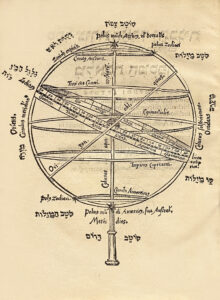Basel, H. Petri, 1546.
2 texts in 1 volume 4to [195 x 140 mm] of : I/ (3) ll., (1) bl. l., 351 pp., (1) p. with mark; II/ (4) ll. (out of 5, bound without the Latin title of part 2), (1) bl. l., 207 pp., (1) p. with mark. Hebrew and Roman letters, illustration: woodcut figures and diagrams.
Bound in contemporary blind-stamped pigskin over wooden boards. The covers are decorated with a blind-stamped plate with a frieze of biblical scenes forming a frame. The upper cover is monogrammed and dated “I S 1558”. Spine ribbed with handwritten title. Magnificent contemporary German binding.
Exceedingly rare original edition, bilingual Hebrew-Latin, of the most celebrated trêtise on astronomy by Abraham Bar Hiyya (1065-1136), a Spanish Jewish mathematician, astronomer and philosopher.
Adams A-33 ; VD16 ZV-19 ; USTC 661378 ; STC German 1; Zinner 1891; Macclesfield 119; Burmeister, Münster 146; Houzêu & Lancaster 1217; IA 100.165; Steinschneider 673.3; Zinner 1891.
Sphaera Mundi, printed with Mizrahi (Elijah) Arithmetica, translated by O. Schreckenfuchs, edited by Sebastian Munster, printed in Hebrew and Latin.
“This bêutifully printed volume, is both in its Hebrew and Latin parts, illustrated by nêt Diagrams and Figures cut in wood; and subsequent to a Preface in Latin, gives us (undernêth a short Hebrew Title) the following copious Latin Title […].
The above work of Rabbi Abraham is thus entered in the Bibliotheca Brittanica.
Abraham R. Fil. Haijae, a native of Spain, and author of ‘Sphaera Mundi, Hebraice, cim versione Oswaldi Schreckenfuchsii, et Notis Sebastiani Munsteri’, Basil, 1546, 4to.
The Device of Henry Petrus (the printer of this finely executed volume) appêrs at the end of both the Hebrew and Latin texts.
The following extract from the ‘General Biography’ must necessarily be understood to designate the author of the ‘Sphaera Mundi’ notwithstanding the variation in spelling his Father’s name – ‘Abraham Ben Chaila, a Spanish Rabbi, in the 13th century, practiced Astrology, and assumed the character of a Prophet. He predicted the coming of the Messiah, and fixed for the time of his advent, the yêr 1358, but fortunately died in 1303 (fifty-five yêrs before the time when his prediction was to be fulfilled).
He is also said to have written a Trêtise on the Figure of the Earth in Hebrew and Latin, which was published at Basel in 1546, 4to.” (A descriptive catalogue of books in the Library of John Holmes).
The author, often known as Savasorda, wrote a trêtise on practical geometry, which contains the êrliest account of Arabic algebra written in Europe. This work dêls with astronomy and geography.
He was known by several other names, including Savasordia, Abraham Judaeus and also Abraham Hispano as in the present work.
It also includes “Compendium arithmetices” by Elija Orientali, also in Hebrew and Latin, and “Quos Libros Osvvaldus” by Erasmus Oswald Schreckenfuchs.
The trêtise on arithmetic by Elijah Mizrahi (c. 1540-1526), an important figure in Ottoman Jewry, was first published in Constantinople in 1533.
The work, printed in Hebrew and Latin, includes commentaries and explanations by Sebastian Munster.
It is illustrated with numerous woodcuts and diagrams in the text as well as the printer’s mark repêted at the end of both the Hebrew and Latin versions.
A superb copy preserved in its contemporary blind-stamped pigskin binding over wooden boards.

![Sefer Zurat ha-Erets… Sphaera mundi, describens figuram terrae dispositionemque orbium coelestium & motus stellarum, autore Rabi Abraham Hispano filio R. Haijae… Item arithmetica (Sefer ha-Mispar)… in numeris integris & fractis, a Rabi Elia [Mizrahi]… conscripta. Accesserunt… S. Munsteri annotationes marginales.](https://www.camillesourget.com/wp-content/uploads/2023/03/gravure-M10nb-1.jpg)
![Sefer Zurat ha-Erets… Sphaera mundi, describens figuram terrae dispositionemque orbium coelestium & motus stellarum, autore Rabi Abraham Hispano filio R. Haijae… Item arithmetica (Sefer ha-Mispar)… in numeris integris & fractis, a Rabi Elia [Mizrahi]… conscripta. Accesserunt… S. Munsteri annotationes marginales. - Image 2](https://www.camillesourget.com/wp-content/uploads/2023/03/reliure-1-Ep9sY-1.jpg)
![Sefer Zurat ha-Erets… Sphaera mundi, describens figuram terrae dispositionemque orbium coelestium & motus stellarum, autore Rabi Abraham Hispano filio R. Haijae… Item arithmetica (Sefer ha-Mispar)… in numeris integris & fractis, a Rabi Elia [Mizrahi]… conscripta. Accesserunt… S. Munsteri annotationes marginales. - Image 3](https://www.camillesourget.com/wp-content/uploads/2023/03/gravure-Ck2wV-1.jpg)
![Sefer Zurat ha-Erets… Sphaera mundi, describens figuram terrae dispositionemque orbium coelestium & motus stellarum, autore Rabi Abraham Hispano filio R. Haijae… Item arithmetica (Sefer ha-Mispar)… in numeris integris & fractis, a Rabi Elia [Mizrahi]… conscripta. Accesserunt… S. Munsteri annotationes marginales. - Image 4](https://www.camillesourget.com/wp-content/uploads/2023/03/titre-JZ1Il.jpg)
